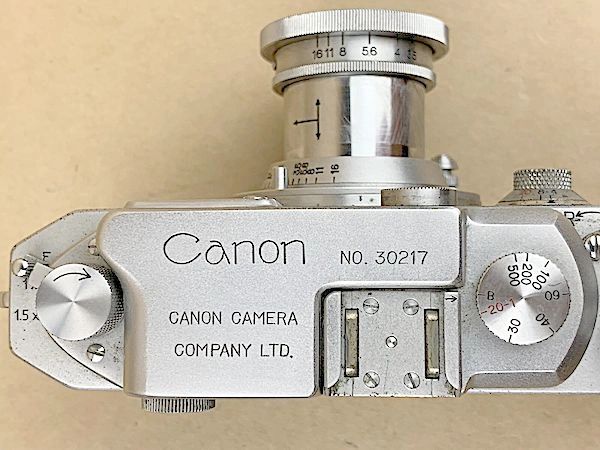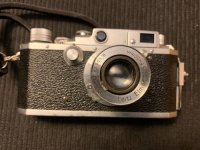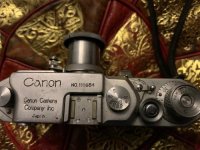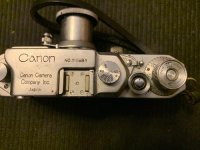In Search of the Best Vintage Canon Rangefinder 35, Part 1
Bottom loading Canons of the ‘50s: Much more than mere Leica copies
By Jason Schneider
The Leica, introduced in 1925 as the minimalist, scale-focusing Leica I (Model A), has had a profound influence on the development of the 35mm camera and on photography in general. In particular, the Leica II (Model D) of 1932 (the first Leica with a built-in rangefinder and coupled interchangeable screw-mount lenses) and the bayonet mount Leica M3 of 1954 (which added a magnificent range/viewfinder with illuminated, auto indexing, parallax compensating frame lines) inspired a horde of imitators that created everything from unabashed copies to ingenious derivatives. However, among the welter of Leica adjacent rangefinder cameras that emerged from the early ‘30s to the late ‘60s only 3 serious competitors emerged: the Zeiss Ikon Contax of 1932 to 1961, the Nikon rangefinder S-mount series of 1948-2005 (the latter date applies if you count the post-SP replicas made after 1962), and the Canon of 1933 (if you count the Kwanon-X of 1933) to 1968. Of these three the Canon was undoubtedly the most successful in terms of worldwide sales in the postwar era, and Leica screw mount Canon cameras ranging from the Canon IIB of 1949-1951 to the very last Canon 7sZ of 1967-1968 are among the best interchangeable lens rangefinder cameras ever made.
%20of%201934.jpg/:/rs=w:1440,h:1440)
KWANON (Canon prototype) of 1934 was the forerunner of a great camera dynasty.
Canon Cameras made prior to the Canon IIB are a fascinating subject unto themselves that is admirably and exhaustively covered in Peter Dechert’s excellent book Canon Rangefinder Cameras 1933-1968, Hove Books, Ltd. 1985 which I’ve used as one of the reference sources for this article, and I heartily commend to Canon fanciers and collectors. However, Canon cameras made before 1949 are really the province of serious collectors and most are rare and priced accordingly. So here I’ll concentrate on my personal favorites, Canons of the 1949-1953 era, all of which are bottom loaders with combined range/viewfinders and Canon’s distinctive “half-hexagonal-ended” form factor. Note: Canon was famous (notorious?) for producing a slew of models with minor variations and occasionally using existing parts on newer models to the confusion of historians and collectors. I will therefore limit my coverage to Canons I’ve seen, handled and owned and leave the taxonomic niceties to other experts who are beyond my pay grade.

Canon IIB with 50mm f/3.5 Serenar lens: It established the form and features of the rangefinder series and may be the most important Canon ever.
The Canon IIB of 1949-1952 was the first Canon with a single eyepiece combined range/viewfinder that also incorporated Canon’s signature 3-step multi-magnification eyepiece (F for full 50mm view, 1.0x for 100mm view, and 1.5x for maximum focusing precision) that’s capable of providing an effective base length (EBL) long enough to focus wide aperture and tele lenses at the flick of a lever. This brilliant innovation took Canon one big technological step beyond the double eyepiece Leica IIIc, IIIf, and even the Leica IIIg of 1957-1960, and it was used on all subsequent rangefinder Canons up to the Canon P of 1958-1961, which showed reflected parallax-compensating frame lines for 35mm, 50mm, and 100mm lenses all at once. Other features: bottom loading, horizontal cloth focal plane shutter with separate front mounted slow speed dial with speeds of 1/20 sec and slower, a top-mounted fast speed dial with shutter speeds of 1/20-1/500 sec plus B, and traditional knob wind and rewind. The Canon IIB was made in early and late versions with minor variations and those made before 1952 are stamped “Made in Occupied Japan” on their base plates. Standard lenses: 50mm f/3.5 Serenar or 50mm f/1.9 Serenar, both collapsible. The Canon IIB is a lovely camera and fine user collectible, but it’s scarcer and often pricier than later Canons such as the III, IIIA, IVS and IVSB, which are better, more economical choices for vintage shooters. $200-$300, body only; $300-450 with 50mm collapsible lens.

Top view of Canon IIB showing selector lever for Canon's signature 3-position eyepiece below rewind knob at left.

Bottom view of Canon IIB of c.1950 shows Made in Occupied Japan inscription required on all postwar Japanese cameras exported before 1952.
Canon III and IV: Released in 1951 both models featured a new coated cloth focal plane shutter with a top speed of 1/1000 sec, and a slow speed dial on the front split at 1/25 sec (instead of the previous 1/20 sec) that now provided a T setting. The bodies have a small hole below the lens mount for a flash sync wire and additional holes below the rewind knob for attaching a new flash sync rail, but these were filled in on the Canon III, which didn’t offer flash sync. However, both models (along with the rare, lower priced IIC of 1951 which had a top shutter speed of 1/500 sec) retained the popular 3-position eyepiece and lever selector that debuted on the Canon IIB. The Canon IV was the first Canon rangefinder 35 with built-in flash sync and can be identified by the flash sync rail on the side of the body below the rewind knob. All 3 Canons released in 1951 also had a revised rewind mechanism and their advance/rewind levers are mounted on a little hump on the top cover. Only 1,400 units of the Canon IV were produced, making it a scarce collector’s prize. Canon III: $300-350, body only; about $100 more with with 50mm f/1.9 Serenar lens. Canon IIC, $600-$1,000 with or without lens; Canon IV, about $400 body only in pristine condition, but $150-S200 for examples in average condition.

Canon III of 1952 with collapsible 50mm f/1.9 Serenar lens had standardized Leica compatible (LTM) screw mount.

Canon IV body. It was the first Canon with built-in flash sync. Note flash mounting rail on side of body below rewind knob.
Canon IIIA, IVF, and IVS: Introduced in 1952 these were the first Canons to use a standard M39 Leica screw mount (LTM) that’s fully compatible with threaded Leica lenses. Previous models employed a “semi-universal” flange that had a slightly different pitch that could occasionally give trouble with mounting and rangefinder coupling Leica and other non-Canon screw mount lenses. I’ve never experienced this myself, but the problem is too well documented to be dismissed as apocryphal. Other changes: a more robust single piece eyepiece magnification lever, and revised rewind and wind knobs, the latter now incorporating an ASA film speed reminder. The standard lens sold with the IIIA was new rigid 6-element, 4-group 50mm f/1.8 Canon in chrome that was renowned for its high resolution and outstanding image quality and remained in production until the last Canon rangefinder camera rolled off the production line. The Canon IVF and IVS were updated versions of the Canon IV that incorporated all the minor changes built into the Canon IIIA. The IVS also employed a new solid metal shutter housing in place of the one in the IVF and previous Canons that was assembled from sheet metal parts. 1952 also saw the expansion of the Canon lens range, which now included, in addition to the previously noted 50mm f/1.8, the 35mm f/3.2, 50mm f/1.5, 85mm f/2, 100mm f/4, and 135mm f/3.5 all with optional accessory viewfinders as needed. Canon IIIA with 50mm f/1.8 Canon, $250-$400; body only $150-200; Canon IVF with 50mm f/1.8 Canon, $325-$400; body, $250-$325; Canon IVS, $250-$350, about $100 more with 50mm f/1.8 Canon lens.

Canon IIIA shown with the legendary 50mm f/1.8 Canon rigid mount lens that Canon offered in various forms until the last of the screw mount Canons.

Canon IVF: It's basically an upgraded Canon IV incorporating all the improvements built into the Canon IIIA.
Canon IVSB2: Announced in 1953 and produced from 1954 to 1956 Canon historian Peter Dechert noted, “The Canon IVSB2 was, after the Canon IIB, the second most important rangefinder camera in Canon’s history.” He concluded that “it surely was the finest bottom loading 35mm rangefinder camera anyone has ever built.” It still had separate fast and slow shutter speed dials, this time separated at 1/30 sec, but an independent spindle rotating with the fast dial included the fast speed index mark so the shutter speed could be set with the shutter either unwound or wound. All speeds were in the modern geometric sequence, with T,1,2,4,8,15, X and 30 on the locking slow speed dial and B, 30-1, X, 60, 125, 250, 500, and 1000 on the fast dial. The X sync setting corresponds to about 1/45 sec. Another major improvement was a slightly larger eyepiece with greater optical magnification which made viewing and focusing noticeably easier. Like earlier models it’s compatible with Canon’s excellent base plate trigger winder and it features the new solid diecast body construction with a rail on the side below the rewind knob, providing a robust flash connection that’s far superior to a PC outlet.

Canon IVSB2: Last and best of the bottom loading rangefinder Canons it has a larger viewfinder and improved shutter mechanism.
Canon claimed that the IVSB2 was the world’s first camera synchronized for electronic flash, aka strobes. Whether that was literally true or not the camera was widely adopted by pros, and it was the first Canon to qualify as a best seller in both North America and Europe. Note: This camera is often listed by sellers as a Canon IVS2 or as a Canon IVSB so check the features carefully to be sure you’re buying the right model. For the record, the Canon IIS2 is basically a IVSB2 with a top shutter speed of 1/500 sec; the Canon IID2 and IIF2 are essentially unsynchronized versions of the IIS2. The Canon IVSB2 currently fetches about $200-$350 body only; the Canon IID2 bodies in clean condition go for about $150-$250.

The Ultimate Base Loading Canon Outfit: Canon IBSB2 with 50mm f/1.8 Canon lens in chrome, all in mint condition.
The great base-loading Canons were superseded by the back loading Canon VT of 1956-1957 and its glorious successors, which will soon be covered In my follow-up piece cleverly entitled “In Search of the Best Vintage Canon Rangefinder 35, Part 2.”
Bottom loading Canons of the ‘50s: Much more than mere Leica copies
By Jason Schneider
The Leica, introduced in 1925 as the minimalist, scale-focusing Leica I (Model A), has had a profound influence on the development of the 35mm camera and on photography in general. In particular, the Leica II (Model D) of 1932 (the first Leica with a built-in rangefinder and coupled interchangeable screw-mount lenses) and the bayonet mount Leica M3 of 1954 (which added a magnificent range/viewfinder with illuminated, auto indexing, parallax compensating frame lines) inspired a horde of imitators that created everything from unabashed copies to ingenious derivatives. However, among the welter of Leica adjacent rangefinder cameras that emerged from the early ‘30s to the late ‘60s only 3 serious competitors emerged: the Zeiss Ikon Contax of 1932 to 1961, the Nikon rangefinder S-mount series of 1948-2005 (the latter date applies if you count the post-SP replicas made after 1962), and the Canon of 1933 (if you count the Kwanon-X of 1933) to 1968. Of these three the Canon was undoubtedly the most successful in terms of worldwide sales in the postwar era, and Leica screw mount Canon cameras ranging from the Canon IIB of 1949-1951 to the very last Canon 7sZ of 1967-1968 are among the best interchangeable lens rangefinder cameras ever made.
%20of%201934.jpg/:/rs=w:1440,h:1440)
KWANON (Canon prototype) of 1934 was the forerunner of a great camera dynasty.
Canon Cameras made prior to the Canon IIB are a fascinating subject unto themselves that is admirably and exhaustively covered in Peter Dechert’s excellent book Canon Rangefinder Cameras 1933-1968, Hove Books, Ltd. 1985 which I’ve used as one of the reference sources for this article, and I heartily commend to Canon fanciers and collectors. However, Canon cameras made before 1949 are really the province of serious collectors and most are rare and priced accordingly. So here I’ll concentrate on my personal favorites, Canons of the 1949-1953 era, all of which are bottom loaders with combined range/viewfinders and Canon’s distinctive “half-hexagonal-ended” form factor. Note: Canon was famous (notorious?) for producing a slew of models with minor variations and occasionally using existing parts on newer models to the confusion of historians and collectors. I will therefore limit my coverage to Canons I’ve seen, handled and owned and leave the taxonomic niceties to other experts who are beyond my pay grade.

Canon IIB with 50mm f/3.5 Serenar lens: It established the form and features of the rangefinder series and may be the most important Canon ever.
The Canon IIB of 1949-1952 was the first Canon with a single eyepiece combined range/viewfinder that also incorporated Canon’s signature 3-step multi-magnification eyepiece (F for full 50mm view, 1.0x for 100mm view, and 1.5x for maximum focusing precision) that’s capable of providing an effective base length (EBL) long enough to focus wide aperture and tele lenses at the flick of a lever. This brilliant innovation took Canon one big technological step beyond the double eyepiece Leica IIIc, IIIf, and even the Leica IIIg of 1957-1960, and it was used on all subsequent rangefinder Canons up to the Canon P of 1958-1961, which showed reflected parallax-compensating frame lines for 35mm, 50mm, and 100mm lenses all at once. Other features: bottom loading, horizontal cloth focal plane shutter with separate front mounted slow speed dial with speeds of 1/20 sec and slower, a top-mounted fast speed dial with shutter speeds of 1/20-1/500 sec plus B, and traditional knob wind and rewind. The Canon IIB was made in early and late versions with minor variations and those made before 1952 are stamped “Made in Occupied Japan” on their base plates. Standard lenses: 50mm f/3.5 Serenar or 50mm f/1.9 Serenar, both collapsible. The Canon IIB is a lovely camera and fine user collectible, but it’s scarcer and often pricier than later Canons such as the III, IIIA, IVS and IVSB, which are better, more economical choices for vintage shooters. $200-$300, body only; $300-450 with 50mm collapsible lens.

Top view of Canon IIB showing selector lever for Canon's signature 3-position eyepiece below rewind knob at left.

Bottom view of Canon IIB of c.1950 shows Made in Occupied Japan inscription required on all postwar Japanese cameras exported before 1952.
Canon III and IV: Released in 1951 both models featured a new coated cloth focal plane shutter with a top speed of 1/1000 sec, and a slow speed dial on the front split at 1/25 sec (instead of the previous 1/20 sec) that now provided a T setting. The bodies have a small hole below the lens mount for a flash sync wire and additional holes below the rewind knob for attaching a new flash sync rail, but these were filled in on the Canon III, which didn’t offer flash sync. However, both models (along with the rare, lower priced IIC of 1951 which had a top shutter speed of 1/500 sec) retained the popular 3-position eyepiece and lever selector that debuted on the Canon IIB. The Canon IV was the first Canon rangefinder 35 with built-in flash sync and can be identified by the flash sync rail on the side of the body below the rewind knob. All 3 Canons released in 1951 also had a revised rewind mechanism and their advance/rewind levers are mounted on a little hump on the top cover. Only 1,400 units of the Canon IV were produced, making it a scarce collector’s prize. Canon III: $300-350, body only; about $100 more with with 50mm f/1.9 Serenar lens. Canon IIC, $600-$1,000 with or without lens; Canon IV, about $400 body only in pristine condition, but $150-S200 for examples in average condition.

Canon III of 1952 with collapsible 50mm f/1.9 Serenar lens had standardized Leica compatible (LTM) screw mount.

Canon IV body. It was the first Canon with built-in flash sync. Note flash mounting rail on side of body below rewind knob.
Canon IIIA, IVF, and IVS: Introduced in 1952 these were the first Canons to use a standard M39 Leica screw mount (LTM) that’s fully compatible with threaded Leica lenses. Previous models employed a “semi-universal” flange that had a slightly different pitch that could occasionally give trouble with mounting and rangefinder coupling Leica and other non-Canon screw mount lenses. I’ve never experienced this myself, but the problem is too well documented to be dismissed as apocryphal. Other changes: a more robust single piece eyepiece magnification lever, and revised rewind and wind knobs, the latter now incorporating an ASA film speed reminder. The standard lens sold with the IIIA was new rigid 6-element, 4-group 50mm f/1.8 Canon in chrome that was renowned for its high resolution and outstanding image quality and remained in production until the last Canon rangefinder camera rolled off the production line. The Canon IVF and IVS were updated versions of the Canon IV that incorporated all the minor changes built into the Canon IIIA. The IVS also employed a new solid metal shutter housing in place of the one in the IVF and previous Canons that was assembled from sheet metal parts. 1952 also saw the expansion of the Canon lens range, which now included, in addition to the previously noted 50mm f/1.8, the 35mm f/3.2, 50mm f/1.5, 85mm f/2, 100mm f/4, and 135mm f/3.5 all with optional accessory viewfinders as needed. Canon IIIA with 50mm f/1.8 Canon, $250-$400; body only $150-200; Canon IVF with 50mm f/1.8 Canon, $325-$400; body, $250-$325; Canon IVS, $250-$350, about $100 more with 50mm f/1.8 Canon lens.

Canon IIIA shown with the legendary 50mm f/1.8 Canon rigid mount lens that Canon offered in various forms until the last of the screw mount Canons.

Canon IVF: It's basically an upgraded Canon IV incorporating all the improvements built into the Canon IIIA.
Canon IVSB2: Announced in 1953 and produced from 1954 to 1956 Canon historian Peter Dechert noted, “The Canon IVSB2 was, after the Canon IIB, the second most important rangefinder camera in Canon’s history.” He concluded that “it surely was the finest bottom loading 35mm rangefinder camera anyone has ever built.” It still had separate fast and slow shutter speed dials, this time separated at 1/30 sec, but an independent spindle rotating with the fast dial included the fast speed index mark so the shutter speed could be set with the shutter either unwound or wound. All speeds were in the modern geometric sequence, with T,1,2,4,8,15, X and 30 on the locking slow speed dial and B, 30-1, X, 60, 125, 250, 500, and 1000 on the fast dial. The X sync setting corresponds to about 1/45 sec. Another major improvement was a slightly larger eyepiece with greater optical magnification which made viewing and focusing noticeably easier. Like earlier models it’s compatible with Canon’s excellent base plate trigger winder and it features the new solid diecast body construction with a rail on the side below the rewind knob, providing a robust flash connection that’s far superior to a PC outlet.

Canon IVSB2: Last and best of the bottom loading rangefinder Canons it has a larger viewfinder and improved shutter mechanism.
Canon claimed that the IVSB2 was the world’s first camera synchronized for electronic flash, aka strobes. Whether that was literally true or not the camera was widely adopted by pros, and it was the first Canon to qualify as a best seller in both North America and Europe. Note: This camera is often listed by sellers as a Canon IVS2 or as a Canon IVSB so check the features carefully to be sure you’re buying the right model. For the record, the Canon IIS2 is basically a IVSB2 with a top shutter speed of 1/500 sec; the Canon IID2 and IIF2 are essentially unsynchronized versions of the IIS2. The Canon IVSB2 currently fetches about $200-$350 body only; the Canon IID2 bodies in clean condition go for about $150-$250.

The Ultimate Base Loading Canon Outfit: Canon IBSB2 with 50mm f/1.8 Canon lens in chrome, all in mint condition.
The great base-loading Canons were superseded by the back loading Canon VT of 1956-1957 and its glorious successors, which will soon be covered In my follow-up piece cleverly entitled “In Search of the Best Vintage Canon Rangefinder 35, Part 2.”











